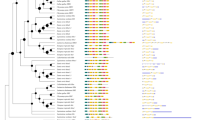Summary
The variations of evolutionary rates in hemoglobins and cytochrome c among various lines of vertebrates are analysed by estimating the variance. The observed variances appear to be larger than expected purely by chance.
If the amino acid substitutions in evolution are the result of random fixation of selectively neutral or nearly neutral mutations, the evolutionary rate of cistrons can be represented by the integral of the product of mutation rate and fixation probability in terms of selective values around the neutral point. This integral is called the effective neutral mutation rate.
The influence of effective population number and generation time on the effective neutral mutation rate is discussed. It is concluded that the uniformity of the rate of amino acid substitutions over diverse lines is compatible with random fixation of neutral or very slightly deleterious mutations which have some chance of being selected against during the course of substitution. On the other hand, definitely advantageous mutations will introduce significant variation in the substitution rate among lines. Approximately 10% of the amino acid substitutions of average cistrons might be adaptive and create slight but significant variations in evolutionary rate among vertebrate lines, although the uniformity of evolutionary rate is still valid as a first approximation.
Similar content being viewed by others
References
Buettner-Janusch, J., Hill, R. L.: Evolution of hemoglobin in primates. In: Evolving genes and proteins, V. Bryson, & H. J. Vogel eds., p. 167–181. New York: Academic Press 1965.
Crow, J. F., Kimura, M.: An introduction to population genetics theory. New York: Harper & Row 1970.
Dayhoff, M. O (editor): Atlas of protein sequence and structure. National Biomedical Research Foundation. Maryland: Silver Spring 1969.
Fitch, W. M.: Systematic Zoology19, 99–113 (1970).
Haldane, J. B. S.: Evolution3, 51–56 (1949).
—, J. Genet.55, 511–524 (1957).
Kimura, M.: Ann. Math. Stat.28, 882–901 (1957).
—, Nature (Lond.)217, 624–626 (1968).
Kimura, M.: Proc. nat. Acad. Sci. (Wash.)63, 1181–1188 (1969).
—, Theoretical population biology2, 174–208 (1971).
—, Ohta, T.: Genetics61, 763–771 (1969).
—, —, Nature (Lond.)229, 467–469 (1971).
King, J. L., Jukes, T. H.: Science164, 788–798 (1969).
Mayo, O.: Nature (Lond.)227, 860 (1970).
Nei, M.: Nature (Lond.)221, 40–42 (1969).
Nolan, C., Margoliash, E.: Ann. Rev. Biochem.37, 727–790 (1968).
Ohno, S., Wolf, U., Atkin, N. B.: Hereditas (Lond.)59, 169–187 (1968).
Ohta, T., Kimura, M.: Nature (Lond.), (in press) (1971a).
- - Jap. Jour. Genet. (in press) (1971b).
Zuckerkandl, E., Pauling, L.: Evolutionary divergence and convergence in proteins. In: Evolving genes and proteins, V. Bryson, & H. J. Vogel eds., p. 97–166. New York: Academic Press 1965.
Author information
Authors and Affiliations
Additional information
Contribution No. 813 from the National Institute of Genetics, Mishima, Shizuokaken 411 Japan. Aided in part by a grant-in-aid from the Ministry of Education, Japan.
Rights and permissions
About this article
Cite this article
Ohta, T., Kimura, M. On the constancy of the evolutionary rate of cistrons. J Mol Evol 1, 18–25 (1971). https://doi.org/10.1007/BF01659391
Received:
Issue Date:
DOI: https://doi.org/10.1007/BF01659391




